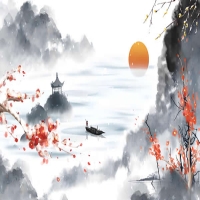在古代诗词中,“娅”字 often appears in contexts describing women's grace or intimate relationships. For instance, in Tang Dynasty poetry, it might be used to depict a young woman's slender figure or gentle demeanor, as seen in some folk songs where "娅" conveys a sense of delicacy and charm. This usage reflects the societal appreciation for feminine beauty and the poetic tradition of using subtle language to express admiration. Moreover, in some poems, "娅" is employed to describe the closeness between friends or lovers, such as in lines that speak of "娅鬟" (elegant hair buns) symbolizing bonded relationships, highlighting how ancient poets valued emotional connections through visual imagery.
Beyond human interactions, "娅" also finds its place in depicting natural scenes. In landscape poetry, it might be used to describe the gentle curve of a branch or the soft whisper of wind, adding a layer of poetic elegance to the description. For example, a Ming Dynasty poet might write, "娅枝轻摇映月华" (the elegant branch sways lightly, reflecting the moonlight), where "娅" enhances the visual and emotional impact, making the scene feel more serene and enchanting. This versatility shows how a single character can bridge the gap between the human and natural worlds, enriching the poetic lexicon.

The cultural significance of "娅" in classical poetry extends to its role in conveying emotions. Often, it serves as a metaphor for tenderness or vulnerability, as in poems that use "娅" to describe a fragile flower or a fleeting moment of beauty. This emotional depth is why "娅" remains a cherished element in literary studies, offering insights into how ancient Chinese writers expressed complex feelings through concise language. In modern times, rediscovering such characters can help us appreciate the nuances of traditional culture and inspire contemporary创作。
In conclusion, the use of "娅" in ancient poetry is a testament to the richness of Chinese literary heritage. It not only adds aesthetic value but also serves as a window into the past, revealing how poets crafted their works with precision and emotion. By exploring these verses, we can better understand the cultural contexts and artistic techniques that have shaped Chinese literature for centuries.
娅的诗句,在古典诗词中如同一抹淡雅的墨痕,悄然点缀着文人墨客的情感世界。这个字虽不常见,却承载着深厚的文化内涵和细腻的情感表达。从唐宋到明清,诗人们用“娅”字描绘女子姿态、自然景致,甚至隐喻人际关系的亲密与和谐。譬如,宋代词人周邦彦在《少年游》中写道:“娅姹黄鹂胜品弦”,以“娅姹”形容黄鹂的婉转鸣叫,仿佛胜过琴弦之音,不仅展现了自然之美,更透露出一种娇柔而灵动的意境。这里的“娅”字,与“姹”结合,形成叠词,增强了语言的韵律感,让读者仿佛置身于春日的园林,耳畔响起鸟语花香。



 相关阅读
相关阅读













